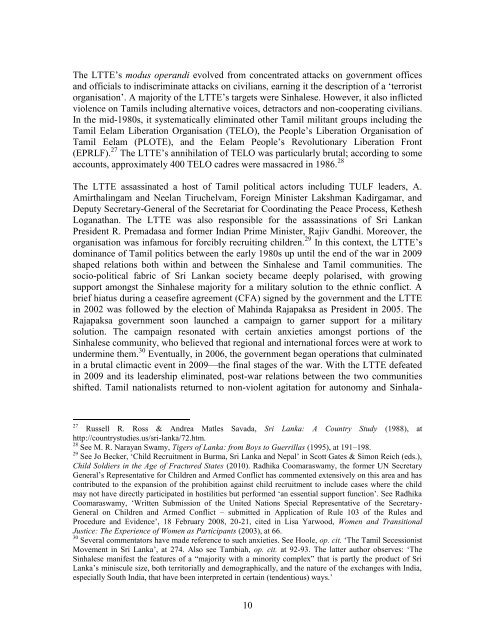Confronting the Complexity of Loss
truth memory justice_final- 11st sep 2015
truth memory justice_final- 11st sep 2015
- No tags were found...
Create successful ePaper yourself
Turn your PDF publications into a flip-book with our unique Google optimized e-Paper software.
The LTTE’s modus operandi evolved from concentrated attacks on government <strong>of</strong>fices<br />
and <strong>of</strong>ficials to indiscriminate attacks on civilians, earning it <strong>the</strong> description <strong>of</strong> a ‘terrorist<br />
organisation’. A majority <strong>of</strong> <strong>the</strong> LTTE’s targets were Sinhalese. However, it also inflicted<br />
violence on Tamils including alternative voices, detractors and non-cooperating civilians.<br />
In <strong>the</strong> mid-1980s, it systematically eliminated o<strong>the</strong>r Tamil militant groups including <strong>the</strong><br />
Tamil Eelam Liberation Organisation (TELO), <strong>the</strong> People’s Liberation Organisation <strong>of</strong><br />
Tamil Eelam (PLOTE), and <strong>the</strong> Eelam People’s Revolutionary Liberation Front<br />
(EPRLF). 27 The LTTE’s annihilation <strong>of</strong> TELO was particularly brutal; according to some<br />
accounts, approximately 400 TELO cadres were massacred in 1986. 28<br />
The LTTE assassinated a host <strong>of</strong> Tamil political actors including TULF leaders, A.<br />
Amirthalingam and Neelan Tiruchelvam, Foreign Minister Lakshman Kadirgamar, and<br />
Deputy Secretary-General <strong>of</strong> <strong>the</strong> Secretariat for Coordinating <strong>the</strong> Peace Process, Ke<strong>the</strong>sh<br />
Loganathan. The LTTE was also responsible for <strong>the</strong> assassinations <strong>of</strong> Sri Lankan<br />
President R. Premadasa and former Indian Prime Minister, Rajiv Gandhi. Moreover, <strong>the</strong><br />
organisation was infamous for forcibly recruiting children. 29 In this context, <strong>the</strong> LTTE’s<br />
dominance <strong>of</strong> Tamil politics between <strong>the</strong> early 1980s up until <strong>the</strong> end <strong>of</strong> <strong>the</strong> war in 2009<br />
shaped relations both within and between <strong>the</strong> Sinhalese and Tamil communities. The<br />
socio-political fabric <strong>of</strong> Sri Lankan society became deeply polarised, with growing<br />
support amongst <strong>the</strong> Sinhalese majority for a military solution to <strong>the</strong> ethnic conflict. A<br />
brief hiatus during a ceasefire agreement (CFA) signed by <strong>the</strong> government and <strong>the</strong> LTTE<br />
in 2002 was followed by <strong>the</strong> election <strong>of</strong> Mahinda Rajapaksa as President in 2005. The<br />
Rajapaksa government soon launched a campaign to garner support for a military<br />
solution. The campaign resonated with certain anxieties amongst portions <strong>of</strong> <strong>the</strong><br />
Sinhalese community, who believed that regional and international forces were at work to<br />
undermine <strong>the</strong>m. 30 Eventually, in 2006, <strong>the</strong> government began operations that culminated<br />
in a brutal climactic event in 2009—<strong>the</strong> final stages <strong>of</strong> <strong>the</strong> war. With <strong>the</strong> LTTE defeated<br />
in 2009 and its leadership eliminated, post-war relations between <strong>the</strong> two communities<br />
shifted. Tamil nationalists returned to non-violent agitation for autonomy and Sinhala-<br />
27<br />
Russell R. Ross & Andrea Matles Savada, Sri Lanka: A Country Study (1988), at<br />
http://countrystudies.us/sri-lanka/72.htm.<br />
28 See M. R. Narayan Swamy, Tigers <strong>of</strong> Lanka: from Boys to Guerrillas (1995), at 191–198.<br />
29 See Jo Becker, ‘Child Recruitment in Burma, Sri Lanka and Nepal’ in Scott Gates & Simon Reich (eds.),<br />
Child Soldiers in <strong>the</strong> Age <strong>of</strong> Fractured States (2010). Radhika Coomaraswamy, <strong>the</strong> former UN Secretary<br />
General’s Representative for Children and Armed Conflict has commented extensively on this area and has<br />
contributed to <strong>the</strong> expansion <strong>of</strong> <strong>the</strong> prohibition against child recruitment to include cases where <strong>the</strong> child<br />
may not have directly participated in hostilities but performed ‘an essential support function’. See Radhika<br />
Coomaraswamy, ‘Written Submission <strong>of</strong> <strong>the</strong> United Nations Special Representative <strong>of</strong> <strong>the</strong> Secretary-<br />
General on Children and Armed Conflict – submitted in Application <strong>of</strong> Rule 103 <strong>of</strong> <strong>the</strong> Rules and<br />
Procedure and Evidence’, 18 February 2008, 20-21, cited in Lisa Yarwood, Women and Transitional<br />
Justice: The Experience <strong>of</strong> Women as Participants (2003), at 66.<br />
30 Several commentators have made reference to such anxieties. See Hoole, op. cit. ‘The Tamil Secessionist<br />
Movement in Sri Lanka’, at 274. Also see Tambiah, op. cit. at 92-93. The latter author observes: ‘The<br />
Sinhalese manifest <strong>the</strong> features <strong>of</strong> a “majority with a minority complex” that is partly <strong>the</strong> product <strong>of</strong> Sri<br />
Lanka’s miniscule size, both territorially and demographically, and <strong>the</strong> nature <strong>of</strong> <strong>the</strong> exchanges with India,<br />
especially South India, that have been interpreted in certain (tendentious) ways.’<br />
10



